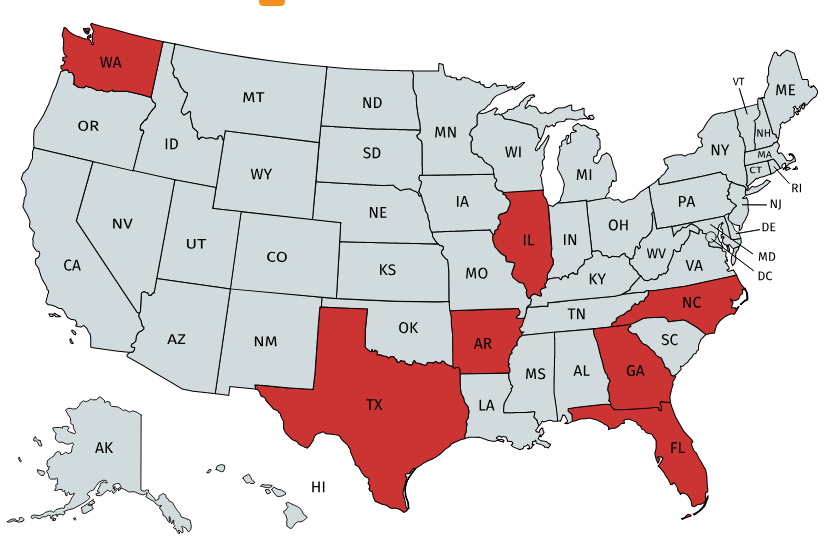Mosquitoes are not considered one of the deadliest animals on planet Earth simply because they exist. The bloodthirsty flying pests are present all over the world (exempting Antarctica). They are one of the most detested animals due to their annoying hum and the itchy bites they leave behind. Mosquitoes have more than 3,000 different species, out of which 175 species can be found in the US.
Every year mosquitoes are responsible for killing more humans than any other animal in existence. According to the WHO, mosquitoes kill more than 700,000 humans per year and they are the culprits behind the global spread of 17 percent of infectious diseases. The drone-like insects are carriers of deadly viruses such as Malaria, Dengue, West Nile virus, Zika, Chikungunya and Yellow fever. Mosquitoes have one of the most widespread fatal impacts ever recorded.
But all life forms as we know it would not be able to survive if mosquitoes were taken out of the equation.. In the US alone the West Nile virus claims more than a 100 lives each year. Subsequently there have been more than 2100 cases of the West Nile virus with a majority of them taking place in California. Back in 2016 more than 36000 cases of the Zika virus were reported in various US territories, especially in Florida and Texas. US cities with the highest populations of mosquitoes:
1. Atlanta
2. Dallas
3. New York
4. Washington
5. Chicago
6. St. Louis
7. Houston
8. Miami
9. Kansas
10. Charlotte
If mosquitoes are so bad why are global health organizations not collectively eradicating them? What is the purpose of their existence on this planet? What will happen if mosquitoes become extinct?
The answer to all these questions can simply be summarized in one word: ‘Ecosystem’
Table of Contents
Role of Mosquitoes in Ecosystem:
Mosquitoes are a vital source of food in the ecosystem and their extinction would impact all life forms on earth. The ecological balance needs to be maintained no matter how detrimental to human welfare.
Being one of the most primitive animals on earth, mosquitoes have been present for more than 100 million years. They have constantly evolved through the centuries to become an important part of ecology. Mosquitoes play a role in ecological phenomenon such as the predator and prey relationship, pollination and reducing aquatic pollution.
Moreover we will never fully know the extent of mosquito interaction with other animals and the impact of their absence.
If mosquitoes were to suddenly die the gap left behind them may even be filled by a more hated and dangerous insect.
Mosquito Larvae: For instance the mosquito larvae are laid in water bodies of all sorts. Some are laid in lakes and streams. As the larvae grow it eats the organic debris, decaying leaves/algae and dead microorganisms present in the water.
Their feeding habits have earned them the position of filter feeders meaning they constantly clean the aquatic system wherein they abide by eating the waste materials. The waste nitrogen excreted by these larvae is in turn used as a food source by the growing aquatic plants underneath water. In a similar manner the mosquito larvae are a source of food for dragonfly, damselfly nymphs, turtles, tadpoles and even fish.
Adult Mosquitoes: The adult mosquitoes are a food source for an even broader spectrum of animals. For example a number of creatures which eat mosquitoes as part of their normal diet include:
- Fish
- Frogs
- Salamander
- Lizards
- Bats
- Bats
- Various larger insects
If mosquitoes were to go extinct it would create a gap in the diet of all these organisms, which in turn would negatively affect larger animals who feed on them. As a food source for a wide range of animals mosquitoes promote species diversity and maintain their populations.
Arctic Tundra: The most negatively impacted by mosquito extinction would be the Arctic Tundra. Mosquitoes are the most dominant insect species in that region of the world. Although mosquitoes are absent in the polar regions, in the Arctic Tundra’s when the ice thaws the land becomes a breeding ground for these insects.
The population of mosquitoes reaches entire swarms, which would appear like giant dark clouds if seen in person. These swarms of mosquitoes aid to a large part of the diet of Arctic birds. For example birds such as Swifts, Swallows, Flycatchers, Nightjars, and Purple Martins all feed on mosquitoes in the Tundra regions. Without mosquitoes these birds will come under stress to find alternative sources of food. Some scientists even claim the arctic ecosystem would collapse if all the mosquitoes were to die. Pollination: Mosquitoes love to drink flower nectar. Therefore a number of plants are pollinated via mosquitoes. The pollens of flowers stick to the eyeballs of mosquitoes when they dive in to drink nectar and then taken to places far away.
Some special flower species are preferably mosquito pollinated meaning a majority of their pollination if carried out by these insects. These plants emit certain specialized smells to attract only mosquitoes.
Prime examples of such flowers are all cold-temperature orchids, especially the blunt-leaved orchid (Platanthera obtusata). These orchids are distributed all over the Arctic Tundra and mostly rely on mosquitoes for their pollination.
Impact of mosquitoes on Human Life:
Due to their disease spreading activities mosquitoes are one of the most hated insects by humans. If mosquitoes were to go extinct all of humanity would probably rejoice.
Since humanity does not fully understand the impact of eliminating these pesky little insects. Fish which feed on mosquito larvae would suffer as a result and it would in turn cause shortage of seafood for humans. In the same way the ecological damage to water bodies across the world would be huge.
Places such as swamps and wetlands would require compulsory drainage and administration of pesticides which in turn would affect bigger animals negatively. The cost and effect of such a situation does not seem beneficial for humans in the larger picture. If all mosquitoes died it would set a chain reaction of unknown events which could even lead to crisis intervention.
Mosquitoes are inspiration for painless micro-needle:
Like all creation the natural physiology of mosquitoes is unique in its own right. Needless to say mosquitoes are capable of inserting a micro-needle in our skin and suck blood effortlessly.
Meanwhile we never even realize our blood is being drawn sometimes for several minutes.
According to scientists at the Ohio State University, it is possible to create a painless micro-needle by studying mosquitoes for biomedical research. They have already identified the mechanism through which mosquitoes pierce human skin and draw blood. By using a technique called Nanoindentation, scientists may very well be able to create a painless state of the art probe.
Vector Mosquitoes:
Infectious diseases caused by mosquitoes are transmitted by only a few species. These mosquitoes are called vector mosquitoes because they are carriers of vector viruses which cause the infectious diseases in humans.
The deadliest species from the mosquito family for human health are Aedes, Anopheles, and Culex. These fragile mosquitoes are identified by their slender long legs and narrow wings. They are responsible for spreading almost all the diseases spread via mosquitoes in humans.
Aedes mosquitoes are known to cause:
- Chikungunya Dengue fever
- Lymphatic filariasis
- Rift Valley fever
- Yellow fever Zika
Anopheles are known to cause:
- Malaria & Lymphatic filariasis
Culex are known to cause:
- Japanese encephalitis
- Lymphatic filariasis
- West Nile fever
Mosquito Genocide:
Certain microbiologists believe genocide of certain species of mosquitoes would a better alternative to extinction of the entire family of insect.
The biologist Olivia Judson first came up with the term ‘specicide’ while proposing the elimination of the thirty mosquito species which cause infectious diseases out of the thirty-five hundred via genetic alterations.
Such an initiative would save more than a million human lives per year without any adverse effects to the ecosystem. Mosquitoes would still exist just the disease causing ones would be terminated.
What is Mosquito Control:
Mosquito control is a technique employed all over the world to limit the population of mosquitoes so they don’t pose a threat to human health and economy. The aim of mosquito control is to manage three problems:
- Stop the spread of infectious diseases
- Restrict influence of mosquitoes in damaging real estate and tourism.
- Protect livestock from mosquito attacks.
Control mosquito populations:
Populations of mosquitoes can be controlled after determining their numbers. There are two main ways for determining the number of a mosquito population within a specific area:
Landing Rate Count:
Mosquito populations can be calculated by counting their landing rates. The technique involves an inspection visit to the site of mosquito germination. It involves manually counting the number of mosquito which land on the body of the inspector during the visit. The technique is repeated over a number of days and the counting is carried out within a time frame. This simple technique is mostly used by small towns’ management systems.
Mechanical Traps
Another way of surveillance on mosquito colonies is by using mechanical traps. This technique is more research based and is carried out with the help of sophisticated apparatus. Mechanical traps count mosquito populations by using a fan which blows the mosquito population into a collection bag. The bag is then taken to a laboratory to count the number of mosquitoes caught and identify their species. Mechanical traps can also use light or chemical stimulus to attract mosquitoes instead of a fan. The trapping technique differs according to the species and gender of mosquitoes to be caught and researched.
From these populations researchers are able to make countless observations such as:
Increase or decrease in the mosquito populations
The different species present in one colony of mosquitoes
The danger of infectious diseases carried by the mosquito population
Identifying the control and health measures required in the human population
Different Methods to Control Mosquitoes:
There are numerous ways of controlling or reducing mosquito populations all over the world. Some of the most used methods are:
Source reduction
Source reduction is a simple yet incredibly effective way of controlling the spread of mosquito populations. All the method consists of is emptying water containers around residential and commercial areas. Mosquitoes lay their larvae on water bodies thereby draining all available water bodies in human populated areas. This eliminates the access to breeding grounds for mosquitoes in a permanent non-toxic way.
Biocontrol
Biocontrol is a technique which uses the predator and prey relationship of the animal kingdom, to suppress the spread of population by introducing its predator in the habitat. For instance in areas such as swamps or lakes, mosquito populations can be controlled by releasing their predators. The Gambusia affinis also known as the Mosquitofish is a natural predator of mosquitoes and is known to feed on their larvae. Similarly dragonflies are known to eat adult mosquitoes. Fungi are also known to trap and digest mosquitoes e.g. Metarhizium anisopliae and Beauveria bassiana are known to kill adult mosquitoes.
Oil Drip
Another effective method of mosquito control is oil drip. A thin layer of oil is coated over water bodies so mosquitoes are unable to lay larvae. The eggs already laid and beneath the oil layer are also unable to come up to surface. In this way mosquitos are not allowed to reproduce. However not all water surfaces can be coated with oil thereby limiting its widespread application.
Adulticides
A number of pesticides and insecticides are used all over the world to curb the outbreak of mosquito-borne disease. In the US the Environmental Protection Agency has underlined a list of pesticides to control the infestation of mosquitoes. The specific pesticides approved by the EPA are called Adulticides because they target disease spreading adult mosquitoes. These adulticides are sprayed either via aircrafts or manually. The approved adulticides include both organophosphate and synthetic insecticides.
Thoughts ? Write a comment below.

